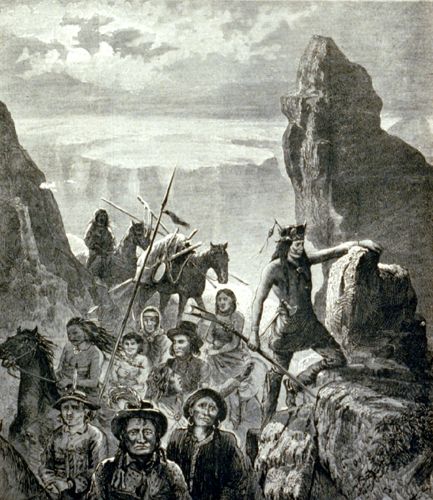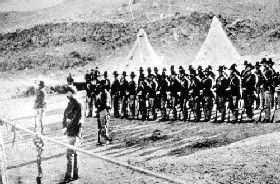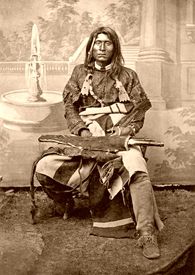
Surrender of the Modoc Indians, 1873, Frank Leslie’s Illustrated Newspaper.
The Modoc War was the only major Indian War fought in California and the only one in which a General of the Regular Army was killed (George A. Custer was not a general when he was killed in 1876 at Little Big Horn). Taking into consideration the number of people involved, this was one of the most costly wars in our history. There were no more than 60 Modoc fighters, and the maximum number of United States troops present at any one time was 600. The war itself ran from November 29, 1872, until June 1, 1873, although tensions leading up to the war began as early as 1826. At the end of the war, the fatalities included 53 United States soldiers, 17 civilians, and 15 Modoc warriors.
The sagebrush-covered lava plateaus and wooded mountains of northern California and southern Oregon had long been the homeland of the Modoc people. Their settlements were scattered along the shores of Tule Lake and the Lost River, where they lived on fish and waterfowl, wild game, and seeds and bulbs from the surrounding countryside.
As white people began to settle near the Lost River, they demanded that the Modoc be removed from their homes and placed on the Klamath Reservation with the Klamath and Yahooskin tribes. The Modoc and the Klamath were historic enemies; the Modoc‘s relationship with the Yahooskin was not much better. For the young Modoc leader Kintpuash, known to the settlers as “Captain Jack,” the Klamath Reservation would never be home.
Kintpuash and other Modoc left the Klamath Reservation, demanding their reservation on the Lost River. However, the Modoc’s presence unnerved the white emigrants, who insisted that the Native Americans be removed again. Oregon Indian Superintendent Alfred Meacham convinced Captain Jack to move back to the reservation at the end of 1869. However, upon their arrival, the Modoc were harassed by the Klamath, and in April 1870, Kintpuash and 371 Modoc moved south once again to their Lost River home.
The Modoc War began on November 28, 1872, when the Bureau of Indian Affairs, under Major John Green, sent troops from Fort Klamath to move the Modoc, “by force if necessary,” back to the reservation. However, when they arrived the next day, many more Modoc were encountered than the Army had expected, and fighting soon broke out. Composed of three groups loosely following the leadership of Kintpuash, the Modoc fled when the troops burned their village.
One group, under the leadership of a warrior called Hooker Jim, proceeded east around Tule Lake, killing 14 male settlers in retaliation for the attack by the troops. Captain Jack and the rest of the Modoc from the Lost River headed across Tule Lake by boat and entered the Lava Beds.
Hooker Jim’s band later joined them. Kintpuash reluctantly accepted them, though he feared that he placed the other Modoc lives in danger by allowing those who had murdered the settlers to stay. Another band of Modoc, the Hot Creeks, eventually joined Kintpuash after settlers had tricked them into thinking that they were all going to be hanged for being Modoc.
Along the shores of Tule Lake, ancient lava flows had formed a rugged, uneven terrain that became known as Captain Jack’s Stronghold. The area was cut with deep lava trenches and dotted with small habitable caves, creating a natural fortification and a seemingly endless variety of places through which one could move unnoticed. Over 300 troops and volunteers were organized to drive the approximately 50 Modoc warriors and their women and children from the Stronghold, capture them, and return them to the Klamath Reservation.
On the foggy morning of January 17, 1873, the troops headed over what they believed was flat land, confident of a Modoc surrender. The Modoc inflicted heavy losses from the cover of their natural stronghold. Confused by the fog and exhausted by the bitter cold and rough terrain, the troops retreated, leaving their weapons, ammunition, and wounded. The Modoc had won a decisive victory and a distinct bargaining advantage in what has become known as the Stronghold Battle.
Many meetings took place between Army leaders and Captain Jack. At each meeting, Kintpuash was still requesting a reservation on the Lost River. To avert further fighting, President Grant organized a Peace Commission to meet unarmed with the Modoc leaders. Captain Jack was willing to negotiate a truce, but Hooker Jim, indicted for murder, had little to gain from a peaceful settlement. He and a shaman, known as Curly-Headed Doctor, convinced Captain Jack in a plot to kill the peace commissioners. Arrangements were made that five unarmed Modoc would meet with the commissioners on April 11, 1873. Frank Riddle and his Modoc wife, Toby, were to attend the meeting as interpreters. Toby Riddle warned the U.S. agents that they would be ambushed, but the men did not heed her warning.
The night before the meeting, Modoc warriors Barncho and Slolux, laden with rifles, hid among the rocks near the peace tent. Civil War hero General Edward Canby, Reverend Thomas, Commission Head Alfred Meacham, and Indian Agent Leroy Dyar left for the meeting in the morning as planned.
Upon reaching the peace tent, the commissioners found not five but eight Modoc, two of which were obviously armed. Captain Jack, Schonchin John, Boston Charley, and Black Jim were among the eight, and they again requested a Lost River reservation. When this could not be granted, Captain Jack drew a revolver and killed Canby. Boston, Charley killed Reverend Thomas. Alfred Meacham was wounded, but Dyar and both the Riddles escaped unharmed.
Four days after the attack on the Peace Commission, a second attack on the Stronghold began. The plan to surround the area was not completed, but the Modoc were cut off from their water supply. On April 17, the troops captured the Stronghold, only to find it empty. Kintpuash and the other Modoc had escaped south toward the Schonchin Lava Flow. Here, they obtained water for their 160 men, women, and children from the nearby ice caves.

U.S. Army at Gillem’s Camp, Lava Beds National Monument, 1873.
On April 26, a patrol of 69 men left Gillem’s Camp in an attempt to locate the Modoc. The patrol was ambushed by 24 Modoc led by Scarfaced Charley. In 45 minutes, two-thirds of the patrol were killed or wounded. The Modoc retreated farther south.
On the morning of May 10, the Modoc were defeated in their surprise attack on troops camped at Dry Lake, leaving most of their horses and supplies in a hasty retreat. Ellen’s Man, George, who was well-liked by all three bands of Modoc, was killed. The whole affair was devastating for the Modoc, who began to quarrel and dissolved into small groups. Hooker Jim left with three men from his band and ten of the Hot Creek band, along with their women and children. They headed west toward the present-day town of Dorris. Kintpuash and his followers left for Big Sand Butte. As troops headed west expecting to locate Captain Jack, they found Hooker Jim and his followers, who surrendered. Hooker Jim and three other Modoc offered to track down Captain Jack and betray him to the Army. Kintpuash finally surrendered at Willow Creek on June 1, 1873, and the Modoc War ended.
Amnesty was granted to Hooker Jim and his followers for their assistance in the capture of Captain Jack, even though they had murdered the 14 settlers at Tule Lake. Those who had attacked the peace commissioners were placed on trial at Fort Klamath and convicted of murder. At the last moment, President Ulysses S. Grant awarded amnesty to Barncho and Slolux, who were sent to Alcatraz. Boston Charley, Black Jim, Schonchin John, and Captain Jack were hanged on the morning of October 3, 1873. The Modoc survivors of the war were exiled to the Quapaw Agency in Oklahoma. Many died over the next few years from unfamiliar diseases and the effects of the harsh climate.
Descendants of seven of the 155 Modoc prisoners of war still reside on the former Quapaw Reservation in Oklahoma. The descendants of those who never left the Klamath Reservation reside in Oregon and elsewhere. Only in recent years have the Modoc begun to return to the Lava Beds. Many still refuse to return to an area with such terrible memories. Others are trying to reestablish their spiritual bonds to the land of their ancestors.
Compiled and edited by Kathy Alexander/Legends of America, updated March 2025. Source: National Park Service
Also See:
Diminishing the Indians in California
Kintpuash, aka: Captain Jack – Modoc Warrior

